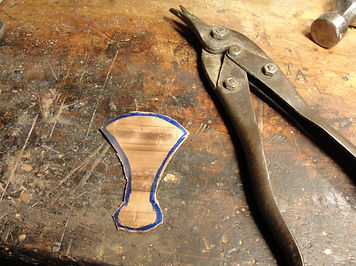Copper Tailpiece made from a piece of pipe
This section details how to make a custom tailpiece for your instrument by using a section of copper pipe. I use this method for most of my Wine Box Bass Guitars as well as many of my relic style guitar builds. It's extremely durable and you can polish it to a shine or age/distress it to get a very nice patina.

Wine Box Bass Guitar with copper Tailpiece
I really enjoy building instruments by using whatever materials I can find.
This section details how I use discarded sections of pipe to make custom tailpieces for my instruments. I use these for most of my Wine Box Bass Guitars as well as many of my relic style guitar builds. It's extremely durable and you can either polish it to a shine or distress it to get a very nice aged patina.
First take a piece of pipe and mark it to the length you need your tailpiece to be. In these photo examples I will be making a Tailpiece for a Cigar Box Guitar.

Using a handsaw I cut to the desired length.

The next step is to make a cut the length of the pipe. The easiest and quickest way is to use a cutting wheel. I use my Dremel tool to do this. Be sure and wear saftey glasses if you choose this method.

Here is the section of pipe after it's been cut.

Now comes the kind of hard part; opening the pipe up.
I use pliers and a screwdriver, sometimes I'll use two pairs of pliers.
When I use the screwdriver it is usually just to get the seam open enough for the pliers.


Locking one end down in a vise while bending with pliers is very helpful.

Once it starts to open up you can lay it on the vise and start to flatten it out further with a hammer.


Once it is flat, roughly mark the shape you want the tailpiece to be. I typically mark with a pencil but in this example I used a marker to make it more visible for the photo.

Use Tin Snips to cut the shape.

At this point you may want/need to hammer the piece some more and possibly file some edges.
Then drill the holes for the number of strings you'll be using and a hole or two for mounting.
Finally you can either clean and polish the piece or distress it to get an aged finish.


Detailed instruction for building several types of roots instruments can be found here:
The Folk Art Instrument Builders Reference
